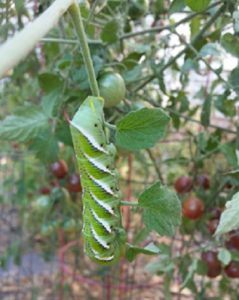Cherish the Tomato Hornworm
As a child I used to love watching moths flutter and circle around the front porch light of our home. Every once in a while, I would get a particular thrill when a moth, which seemed to my young mind, the size of a B52 bomber, would join all of its smaller cousins. That was my first introduction to the sphinx moth.
This started a fascination that has remained with me all my life. This moth is amazingly agile and has often been compared to hummingbirds. It, too, feeds on flower nectar and moves from flower to flower all night long, pollinating as it moves along. In fact, hummingbird moth is one name for these wonderful creatures. They are also known as hawk moths as well because they are such strong fliers. Many people have never encountered the adult form of these insects because they are primarily nocturnal.
Insects can pass through a number of stages in their life cycle that seem totally unrelated to each other. Eggs laid near a food source hatch as caterpillars, which was one of the first sources of my growing awareness of my personal eco-disconnect. The caterpillar stage of my beloved sphinx moth was a – gasp! – tomato hornworm.
One of my favorite garden activities, prior to my growing awareness, was picking these huge caterpillars off my tomato plants and tossing them, one at a time, into our chicken coop. The result was a riot, as every hen tried to get to the worm first, and then dashed madly around trying to keep it for herself. That was entertaining to say the least.
This came to an abrupt end when I researched sphinx moths. There, staring back at me from the screen, was not only a picture of a stately sphinx moth but the dread tomato hornworm. My innocent chicken-baiting days were over. When this caterpillar reached full growth, it would dig into the ground a few inches, and when winter had passed, emerge as a sphinx moth.
Though not a major pollinator of food crops, there are a number of native plants totally dependent on these moths for pollination. In Kauai the green sphinx moth has disappeared and following it into extinction is the Vulcan palm, almost gone in the wild, now mostly surviving as a house plant. There are other sphinx moths that are endangered as well. As the moth goes so too will the native plants that rely on them.
All that being said, I still love tomatoes and a tomato hornworm can destroy a tomato plant pretty quickly. My answer is not elegant but it works for me. I plant more tomatoes than I need anyway so I choose a sacrificial plant and allow the hornworms full reign on that plant, sometimes even moving caterpillars from one plant to another. That way I can have my moths and my tomatoes too.
The eco-disconnect is real and we all play a part in it. Learning how to live as an integral part of the larger eco-system is not just something for tree huggers. It is becoming more and more evident that it is critical to our survival as a species as well.
If you have any questions that are garden-related, call the University of California Cooperative Extension Master Gardeners hotline at (209) 533-5912 or email us at mgtuolumne@ucanr.edu.
Jim Bliss is a University of California Cooperative Extension Master Gardener of Tuolumne County.
UCCE Master Gardeners of Tuolumne and Calaveras Counties can answer home gardening questions. Call 209-533-5912 or fill out our easy-to-use problem questionnaire here. Check out our website here. You can also find us on Facebook.

